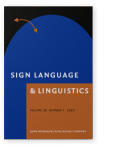Vol. 26:1 (2023) ► pp.37–63
Word order in simple sentences of tri-lingual tri-modal deaf students [*] *
This study explores word order patterns produced by deaf students who use Israeli Sign Language (ISL) and Arabic. Nineteen students participated in a sentence elicitation task in which they retold events portrayed in 24 short videos in three language conditions: signed ISL, spoken Palestinian Arabic and written Modern Standard Arabic. A control group of 19 hearing students was tested in the two Arabic conditions. Results showed that SVO word order was the most frequent in both groups, and in all three languages. SOV word order, which is common in ISL but ungrammatical in Arabic, was produced only by the deaf group. Finally, unique word orders, specific to the signed modality were produced only in the ISL condition. The findings suggest that deaf students are sensitive to the syntactic structures of each language they use and show natural cross-linguistic interaction in their language use.
Article outline
- 1.Introduction
- 1.1Word order in PA and MSA
- 1.2Word order in signed languages
- 1.3Acquisition of word order by deaf children
- 2.Methods
- 2.1Participants
- 2.2Materials
- 2.3Procedure
- 2.4Coding schema
- 3.Results
- 4.Discussion
- 5.Conclusion
- Acknowledgements
- Notes
-
References
